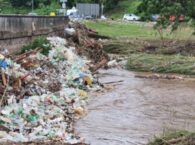Civil engineering students create a master redesign for Ahuska Park
Professor Greg Harrington’s students develop park improvements—which include a wetlands boardwalk, natural playground, and more—to increase recreational engagement.
Metrics
Community
City of Monona, WI, United StatesUniversity
University of Wisconsin - MadisonProgram
UniverCity YearYears
2016/2017Status
CompletedCase Type
Project StoriesRegion
EPA Region 5, USAAt 22 Acres, Ahuska Park is the City of Monona’s second largest park. Hosting a Sunday farmer’s market and numerous sports, from soccer to baseball, the park is a site for considerable activity within the Monona community. While the park is a hub for recreational activities, it comes with some challenges: while city officials and residents have wanted to expand the park for more activities, a surrounding wetland, less than ideal soil quality, and the nearby Beltline Highway provide limitations on growth.
For Monona to move toward redeveloping Ahuska Park, they will need to conduct numerous geological engineering studies to better understand soil conditions, land usability, and development feasibility.
The UniverCity Year program of the University of Wisconsin-Madison, an EPIC-Network member, was created to help local government and community partners with identified sustainability and livability projects. Participating University faculty incorporate community-identified projects into classes, and provide students with on-the-ground experience in support of a more sustainable and livable future for the partnered community.
During the 2016 to 2017 academic year, the City of Monona was chosen to partner with the UniverCity Year program due to its proximity to the university and for strong support from Mayor Bob Miller.
Professor Harrington’s students get to the drawing board
The UniverCity Year program partnered UW-Madison’s Civil Engineering 578: Senior Capstone Design course with the City of Monona to help in the redevelopment of Ahuska Park. At the direction of Professor Greg Harrington, students developed designs for the construction of infrastructure and site improvements which would strengthen engagement among the community, the park, and the neighboring wetlands.
To achieve this, students completed the following procedures:
- Created three park design alternatives
- Conducted evaluation of sustainability for each of the three proposed designs
- Collected community input from a public information meeting and site visits
A park design which appeals to all visitors and residents
Students provided numerous recommendations for the redevelopment of Ahuska Park, all of which were contained in a chosen final design which was appealing to the largest demographic and has the “greatest potential to offer long-lasting value” to the City of Monona. This site design involved the following improvements:
- Increasing park activities by adding a dog exercise area, a youth soccer field, and a natural playground
- Adding permeable asphalt walking paths which connect new features to sport courts and parking
- Upgrading the existing parking lot with permeable asphalt to better manage stormwater
- Creating a boardwalk along the wetlands which features an observation tower, allowing for better access to nature without leaving the city
The completed student design entered into the submittal phase of contracting, wherein all legal construction documents and planning initiatives were submitted to the City of Monona. Upon implementation of the final design, Monona hopes to see recreational and environmental benefits for years to come.
After the initial collaboration, Monona staff continued to work with professor Greg Harrington examining transportation improvements along the Broadway corridor, and to identify future projects that will carry on study of this complex area.
This plan was developed to outline the city’s vision for the revitalization and redevelopment of the Broadway corridor after the Beltline Highway’s construction in the early 1990s.


